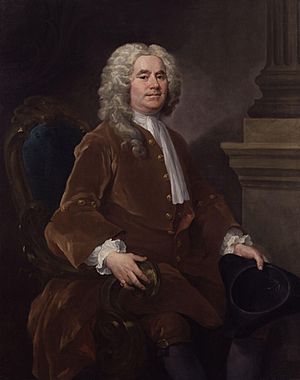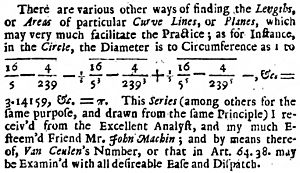William Jones (mathematician) facts for kids
Quick facts for kids
William Jones
|
|
|---|---|

Portrait of William Jones by William Hogarth, 1740 National Portrait Gallery
|
|
| Born | 1675 Llanfihangel Tre'r Beirdd,
Isle of Anglesey |
| Died | 3 July 1749 (aged 73–74) London, England
|
William Jones (1675 – 1 July 1749) was a Welsh mathematician. He is famous for being the first person to use the symbol π (the Greek letter Pi) to stand for the ratio of a circle's circumference to its diameter. This is the number we now call Pi.
Jones was a close friend of two very important scientists: Sir Isaac Newton and Sir Edmund Halley. In 1711, he became a member of the Royal Society, which is a famous group for scientists. Later, he even became its vice-president.
Contents
Who Was William Jones?
William Jones was born in 1675 in a small village called Llanfihangel Tre'r Beirdd. This village is on the Isle of Anglesey in Wales. His parents were Siôn Siôr and Elizabeth Rowland.
Early Life and Education
William went to a special school called a charity school in Llanfechell, also on Anglesey. People quickly noticed how good he was at math. A local landowner, Lord Bulkeley, saw his talent. Lord Bulkeley helped William get a job in a merchant's office in London. The Bulkeley family and later the Earl of Macclesfield were important people who supported him.
Working at Sea
From 1695 to 1702, William Jones worked on Navy ships. He taught mathematics to sailors. During this time, he became very interested in how to navigate ships using math. In 1702, he published a book called A New Compendium of the Whole Art of Navigation. In this book, he showed how to use math to figure out a ship's position at sea.
Teaching and Writing Mathematics
After his time at sea, William became a math teacher in London. He taught in coffee houses and also gave private lessons. Some of his students later became important people, like the son of the future Earl of Macclesfield. With their help, he got some easy jobs in government offices.
In 1706, Jones published another book called Synopsis Palmariorum Matheseos. This book was for people just starting to learn math. It included new ideas about differential calculus and infinite series. This is where he first used the symbol π for the ratio of a circle's circumference to its diameter. Other mathematicians had used similar ideas before him. In 1711, his work Analysis per quantitatum series, fluxiones ac differentias introduced a special dot symbol for differentiation in calculus.
Friends and Family
William Jones became friends with two of Britain's most famous mathematicians: Edmund Halley and Sir Isaac Newton. Because of his work and friendships, he was chosen to be a member of the Royal Society in 1711.
He later helped edit and publish many of Sir Isaac Newton's writings. William Jones also collected an amazing library of books about science and math. It was one of the biggest collections of its kind.
William Jones was married twice. His first wife was the widow of his old employer, and he inherited her property when she passed away. In 1731, he married Mary Nix, who was 22 years old. They had two children who lived to be adults. His son, also named William Jones, was born in 1746. This son became a famous expert in languages. He found connections between Latin, Greek, and Sanskrit, which led to the idea of the Indo-European language family.
Images for kids
See also
 In Spanish: William Jones (matemático) para niños
In Spanish: William Jones (matemático) para niños



